The NVIDIA GeForce GTX 660 Review: GK106 Fills Out The Kepler Family
by Ryan Smith on September 13, 2012 9:00 AM ESTOC: Power, Temperature, & Noise
Before wrapping things up, we wanted to quickly take a look at the overclocking potential of the GTX 660. As the first GK106 product GTX 660 should give us some idea as to how capable GK106 is at overclocking, though like GK104 we’re eventually at the mercy of NVIDIA’s locked voltages and limited power target control.
In its rawest form, GTX 660 will have two things going against it for overclocking. First and foremost, as the highest clocked GK106 part it’s already starting out at a fairly high clockspeed – 980MHz for reference cards, and upwards of 1050MHz for factory overclocked cards – so there may not be a great deal of overclocking headroom left to exploit. Furthermore because NVIDIA is keeping the power consumption of the card low (it needs to stay under 150W max), the maximum power target is the lowest we’ve seen for any GTX 600 card yet: it’s a mere 110%. As a result even if we can hit a large GPU clock offset, there may not be enough power headroom available to let the GPU regularly reach those speeds.
Memory overclocking on the other hand looks much better. With the same memory controllers and the same spec’d RAM as on the other high-end GTX 600 cards, there’s no reason to believe that the GTX 660 shouldn’t be able to hit equally high memory clocks, which means 6.5GHz+ is a reasonable goal.
| GeForce GTX 660 Overclocking | ||||||
| Ref GTX 660 | EVGA GTX 660 SC | Zotac GTX 660 | Gigabyte GTX 660 OC | |||
| Shipping Core Clock | 980MHz | 1046MHz | 993MHz | 1033MHz | ||
| Shipping Max Boost Clock | 1084MHz | 1123MHz | 1110MHz | 1123MHz | ||
| Shipping Memory Clock | 6GHz | 6GHz | 6GHz | 6GHz | ||
| Shipping Max Boost Voltage | 1.175v | 1.175v | 1.162v | 1.175v | ||
| Overclock Core Clock | 1080MHz | 1096MHz | 1093MHz | 1083MHz | ||
| Overclock Max Boost Clock | 1185MHz | 1174MHz | 1215MHz | 1174MHz | ||
| Overclock Memory Clock | 6.7GHz | 6.9GHz | 6.7GHz | 6.5GHz | ||
| Overclock Max Boost Voltage | 1.175v | 1.175v | 1.162v | 1.175v | ||
Throwing in our factory overclocked cards from our companion roundup, our core overclocking experience was remarkably consistent. The difference in the max boost clock between the slowest and fastest card was a mere 41MHz, with the Zotac card being a clear outlier compared to the rest of our cards. This comes as no great surprise since all of these launch cards are using the NVIDIA reference PCB, so there’s little room at this moment for overclocking innovation.
Memory overclocking is as volatile as ever, with a 400MHz spread between our best and worst cards. Again with the use of the reference PCB (and the same Samsung RAM), memory overclocking is entirely the luck of the draw.
For the moment at least GTX 660 overclocking looks to be on a level playing field due to all partners using the same PCB. For overclockers the choice of a card will come down to pricing, what cooler they prefer, and any preference in vendor.
The end result of all of this is that at best we’re seeing 100MHz overclocks (going by the max boost clock), which represents roughly a 10% overclock. Coupling this with a good memory overclock and the 10% increase in the power target will result in around a 10% increase in performance, which isn’t shabby but also is the same kind of shallow overclocking potential that we’ve seen on cards like the GTX 670 and GTX 660 Ti. All told the GTX 660 isn’t a poor overclocker – 10% more performance for free is nothing to sneeze at – but it’s also not going to enamor itself with hardware overclockers who like to chase 20% or more.
Moving on to our performance charts, we’re going to once again start with power, temperature, and noise, before moving on to gaming performance. Due to popular demand we’ll also be including overclocking results with just a 110% power target so that you can see the impact of adjusting the power target separately from the clock offsets.
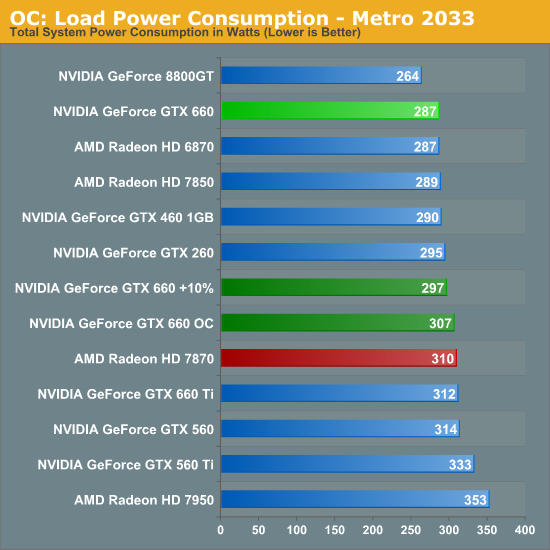
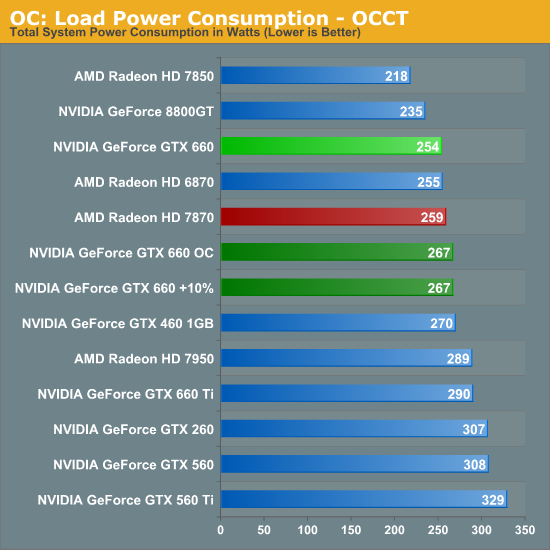
With a 110% power target we should be seeing an 11W-14W increase in power consumption, which is indeed roughly what we’re seeing at the wall after accounting for PSU inefficiencies. In Metro this is just enough of a difference to erase most of the GTX 660’s power consumption advantage over the GTX 660 Ti, though the GTX 660 still draws marginally less power than the stock 7870. Meanwhile under OCCT the GTX 660 now draws more power than the 7870, but still is still drawing over 20W less than the stock GTX 660 Ti.
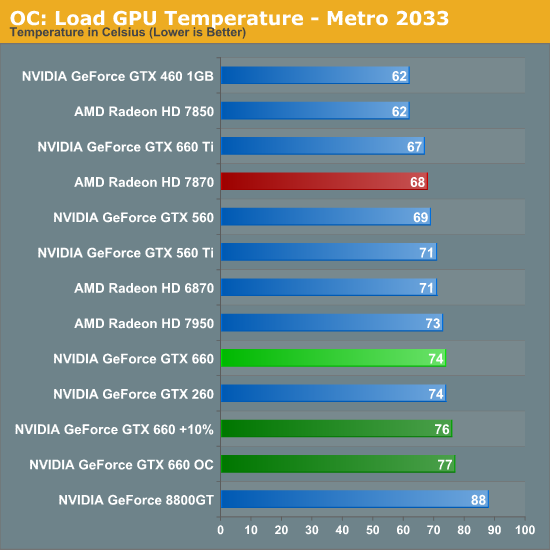
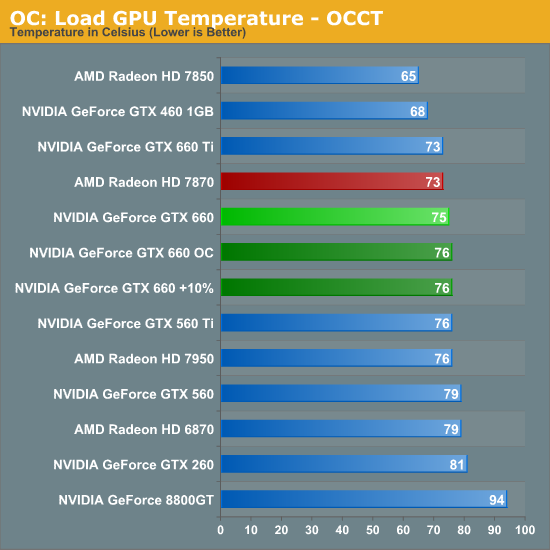
Our increased power consumption pushes temperatures up by another 2-3C. This is nothing a blower can’t handle, let alone an open-air cooler.
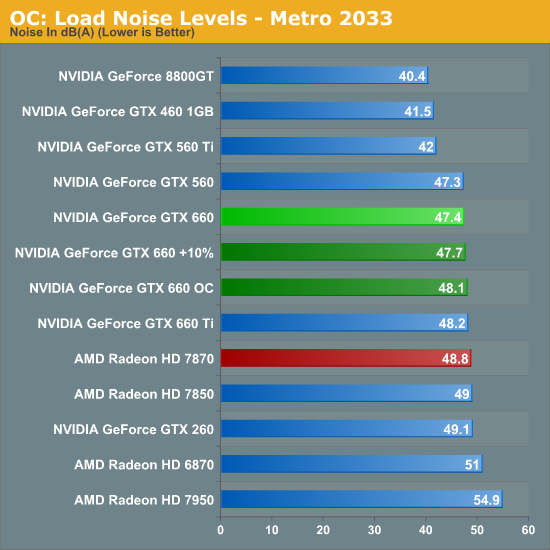
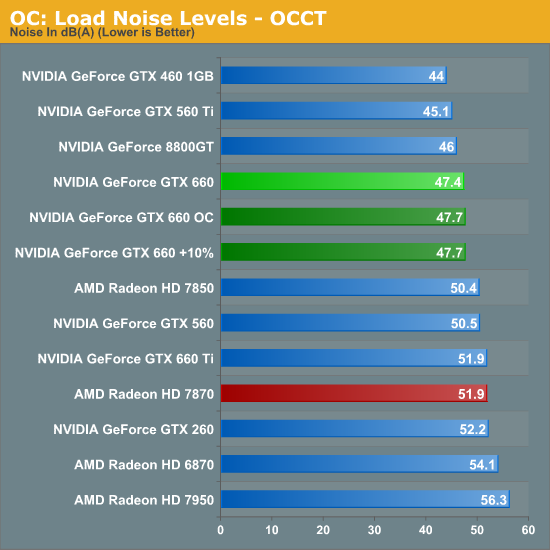
Interestingly enough, despite the increase in power consumption and temperatures, overclocking has almost no impact on noise. In the worst case scenario our GTX 660’s increased its fan speed by all of 2%, which increases noise by less than 1dB. As a result the amount of noise generated by the overclocked GTX 660 is practically identical to that generated by the stock GTX 660, and still below the reference 7870.










147 Comments
View All Comments
MySchizoBuddy - Friday, September 14, 2012 - link
If i'm a new buyer buying the older 560 at a reduced cost both be a better buy correct?Fiercé - Thursday, September 13, 2012 - link
While I may be in the minority, I actually check the "The Test" page of every GPU review in order to see which driver version is being used to test the hardware, as well as to get a quick mental list of 2 or 3 GPUs to watch out for in the FPS comparisons.Due to this I've noticed for this GPU review many cards are listed that don't appear anywhere in the benchmarks:
-AMD Radeon HD 6970
-AMD Radeon HD 7950B (explicitly stated over a non-B)
-AMD Radeon HD 7970
-NVIDIA GeForce GTX 570
-NVIDIA GeForce GTX 670
(Excepting all the GTX 660 Ti that of course can't be re-tested in time for a launch review, but might be useful as a "factory overclocked options" list for a reader looking at base 660 Ti performance.)
Ryan Smith - Thursday, September 13, 2012 - link
Thanks for the heads up. I had copied that out of the GTX 660 Ti article and had not yet edited it. It has been fixed.Fiercé - Thursday, September 13, 2012 - link
Cheers.Jamahl - Thursday, September 13, 2012 - link
That has the 660 faster than the 7870. Most reputable sites have the card squarely in-between the Pitcairns.Rick83 - Thursday, September 13, 2012 - link
It appears to me, that we should be glad, that the jump in performance is that low, as finally it seems the power wars of the last generation, when cards were dumping 200 Watts and more into your case, even when they were just higher mid-end cards, are over.Now of course that means we get slightly less of a performance boost, but at least power consumption of this card is below the level of a GTX260. That is important, as the 560Ti was relatively quite power hungry, especially once the wick on them was turned up a bit, which was being done quite liberally.
While the Performance/Dollar metric isn't that great, the performance/(dollar*power) is probably much better than last gen.
n9ntje - Thursday, September 13, 2012 - link
As everyone said it, nVidia is again late to the party. However, both (amd and nV) haven't done anything to improve the price/performance. First the $100 price range, now the 200?I'm sorry but since I bought my HD5750 almost 3 years(!) ago for 100 bucks. I dont get much more performance with a similair priced card. Now they are doing it the same to the 200 dollar cards..
CeriseCogburn - Thursday, November 29, 2012 - link
Welcome to the new socialist economy and 4 more years of it.Computer prices rise in the new socialist economy.
LOL
It's great, maybe AMD will get a bailout soon.
thorr2 - Thursday, September 13, 2012 - link
I saw the big image on the main page and thought it was a projector at first.cmdrdredd - Thursday, September 13, 2012 - link
Performance is not bad but the pricing is still too high. Start overclocking a 7870 and the 660 looks bad imo.